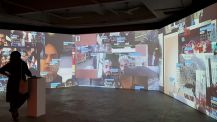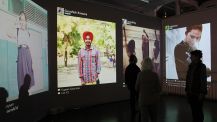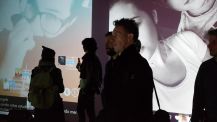Karachi Biennale
Indus Valley School of Art and Architecture, Karatschi, PakistanKuratiert von: Faisal Anwar
Künstler*innen: Alecia Neo, Amin Gulgee, Amin Rehman, Andreas Lutz, Anthony McCall, Audio Placebo Plaza, Cosmic Tribe, Dennis Rudolph, Giselle Beiguelman, Herwig Scherabon, Imran Qureshi, Invisible Flock, KCR Studio, Madyha Leghari, Marc Lee, Nobomichi, PluginHUMAN, Rabeeha Adnan, Rashid Rana, Second Practice, Sheeza Ali, Shezad Dawood, Soliman Lopez, Yasir Darya

IVS Gallery, Karachi Biennale
Collective Imagination: now and the next.
Karachi like other major emerging cosmopolitan cities around the world is at the cusp of the digital revolution, is increasingly generating, connecting and speaking in the language of digital data. As a city with one of the largest and most diverse populations in the world, and being the economic, philanthropic, and educational capital of Pakistan. This voracious consumer of technology, with a population that is primarily youth, initially began to use technology to compensate for a dysfunctional communication infrastructure and today with its experimental thrust it has begun to navigate the 4IR (Fourth Industrial Revolution) narrative, which seeks new ways of making technology an intrinsic and perhaps symbiotic part of human experience. For Karachi Biennale 111, I am investigating the possibilities to conceptualize and materialize the digital liminal space as an innovation corridor of creative encounters and a site of symbolic empowerment and agency.
Our innate desire to form social connections and relationships is going through an unprecedented shift. According to Gerd Leonhard, a futurist speaker and author, “Our world is going to change more in the next 20 years than in the previous 300 years”. The technological transformation characterized by big data, artificial intelligence, blockchain / Crypto currency and automation can’t be a panacea for all the problems caused by unchecked economic growth, exploitation of natural recourses and denial of climate change. Furthermore, the ethical assessment of emerging technologies concerns the broader debate around issues such as privacy, security, and even exacerbated racial, ethnic and economic disparities. This shift also spurred new conversations that have blurred the lines between the real and the fabricated. What are the implications of excessive use of digital mediums and devices on our learning, perceptions, assumptions, and opinions? How is the 4IR shaping our borderless 24/7 society?
Our global cities live without no virtual boarders, we record, share and edit our present; documenting our history and forecasting our future in real-time through strategies that challenge our social and cognitive boundaries. Furthermore, during the COVID-19 pandemic, technology and digital tools have been the driving force in further forcing us to reimage how we live, work, play and communicate; they have generated social and occupational changes that will likely continue even after the crisis has passed. This parallel reality, being normalized as vital and urgent, has become an intrinsic part of to our current human experience with each other and the cities we inhabit. Are today’s societies forming new territories, spaces and conversations which are transitional and transformative?
As the avant-gardes of humanism and harbingers of progressive socio-cultural change, arts have the potential to bridge the physical and imaginative worlds, recognize innovation and harness the power of technology. From the Islamic Golden Age and European Renaissance art to Contemporary and the New Media art, artists as alchemists, scientists, engineers and creative innovators have embraced technology to find original and creative ways of expression. Today, the Hybrid Art is an evolving digital art movement is posing many exciting possibilities, from concept to display and engagement, while prompting questions around the evolving role of the artist. The intersection of art and technology gave rise to a new global wave of artist-led start-ups, art practices and creative collaborations that are transforming conversations, exploring new territories, creating hybrid spaces, and influencing how we will make art for years to come.
This parallel reality, being normalized as vital and urgent, has become an intrinsic part of our current human experience with each other and the cities we inhabit. Are today’s societies forming new territories, spaces and conversations which are transitional and transformative?
As the avant-gardes of humanism and harbingers of progressive socio-cultural change, arts have the potential to bridge the physical and imaginative worlds, recognize innovation and harness the power of technology. From the Islamic Golden Age and European Renaissance art to Contemporary and the New Media art, artists as alchemists, scientists, engineers and creative innovators have embraced technology to find original and creative ways of expression. Today, the Hybrid Art is an evolving digital art movement that is posing many exciting possibilities, from concept to display and engagement, while prompting questions around the evolving role of the artist. The intersection of art and technology gave rise to a new global wave of artist-led start-ups, art practices and creative collaborations that are transforming conversations, exploring new territories, creating hybrid spaces, and influencing how we will make art for years to come.
About Echolocation
We live in a globalised world that is becoming increasingly homogeneous. Languages, plant and animal species are continuously decreasing. Supermarkets, buildings and cities look more and more alike. The "Echolocation" deals with cultural diversity and at the same time with the powerful homogenization forces that are being exerted on this diversity also in the social-digital realm, and poses questions about the meaning of this ever-increasing flattening of forms and images.
In Echolocation users can choose any location on a map and move through stories posted from there by others on social networks like YouTube, Flickr and Twitter. Here these personal impressions are streamed in real time like windows to our changing world. The viewer participates in the social movements of our time and makes a journey into constantly new image and sound collages in which one experiences local, cultural and linguistic differences and more and more similarities.
Ausgestellt
Echolocation – Mapping the Free Flow of Information Around the World in Realtime
Interaktive Netzbasierte Multi-Screen-InstallationLeben wir in einer globalisierten Welt, die immer homogener wird? Sprachen, Pflanzen- und Tierarten verringern sich kontinuierlich. Gebäude, Einkaufszentren und Städte gleichen sich immer mehr. Echolocation beschäftigt sich mit der kulturellen Vielfalt und gleichzeitig mit den starken Homogenisierungskräften, die auch im sozial-digitalen Bereich auf diese Vielfalt einwirken, und stellt Fragen mehr …

IVS Gallery, Karachi Biennale

ZKM, Karlsruhe

Aktionshalle, Zurich